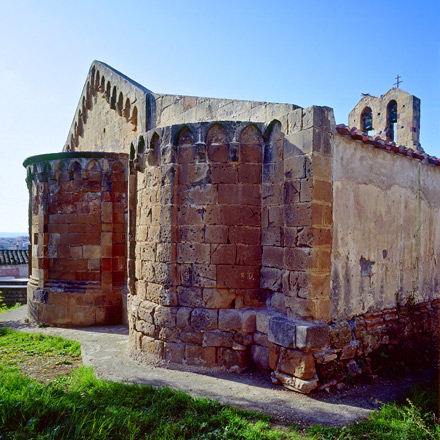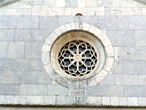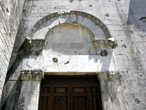The Church
The pieve of Santo Stefano in Vallecchia was built on the side of the road leading from Pietrasanta to Seravezza, following the same track of the ancient Via Francigena; in the Middle Ages, it marked the southern boundary of the diocese of Luni, extending its jurisdiction on the whole territory of Seravezza. The edifice, whose plan can be referred to the 12th century, was largely reworked throughout the centuries; today, fragments of the original masonry can only be identified in the external base and, more extensively, on the apse.
Description »
The building has got a rectangular, three-nave plan, marked by arcades resting on columns, and a semicircular apse. The plain gable front hosts a portal with triangular tympanum, two side portals with plain doorposts and a rose window. Earlier opening types are represented by the apsidal single-light windows, with monolithic archivolt, referring to the construction of the building in the 12th century. The medieval wall face, in the still visible parts, consists of large-sized, perfectly squared limestone ashlars coming from the nearby quarries of Solaio. The façade is plastered, as well as the front part of the northern side and the whole southern side.
The bell tower, rebuilt after the German withdrawal had made it collapse in 1945, rises free-standing to the south of the church.
History »
The pieve of S. Stefano was first mentioned in a document of 881, although the present edifice layout may be referred to the 12th century. In the subsequent centuries, the church underwent a number of interventions: in the second half of the 13th century, a period of fights among Lucca, Pisa and the rulers of Corvaia and Vallecchia ended up in the destruction of the borough, to the extent that the inhabitants were transferred to the nearby Pietrasanta and Camaiore. Even the pieve was involved and, towards the end of the century, a considerable restoration implied the reconstruction of part of the masonry and piers next to the choir, as shown by the capitals reminiscent of Gothic style that are still in place.
A document of 1596 confirms that, since then, new restoration works were started, including the replacement of a few columns, the creation of the main portal and the construction of new altars.
In the same way as the whole Medicean Versilia, it passed from Luni to the Pisa diocese in 1798.
Works »
Recently, the apsidal basin fresco was restored: featuring Christ the Judge between the Virgin and St. John, it refers to the late 14th century, like a work of analogous subject, yet of a superior quality, found in the pieve of Valdicastello.
Restorations »
In 1945, the German withdrawal bombed the bell tower of S. Stefano pieve, which crumbled on the southern side of the church, causing the partial destruction of the right aisle. Following such disastrous event, remarkable restoration and reset works were started in 1946, including the reconstruction of the parts collapsed, a review of covers, with the dismantling of the vaults over the aisles, and the removal of chalk frames. The bell tower would be rebuilt in 1949.
The church made the object of renovations again in the 1970’s, as the plasters and the 14th-century fresco of the apsidal basin were showing degradation signs. Yet, a more significant intervention would be carried out in 1981, when all the covers were consolidated, the ceiling was repainted and the internal arcade restored.
Bibliography »
M.P. Gavioli Andres, L. Luisi Galleni, Pievi romaniche della Versilia: itinerari storico-artistici, Lucca 1999, pp. 83-92.
M.T. Filieri, S. Russo (a cura di), La piana lucchese e la Versilia, Milano 2000, p. 126.
Location
Dating
12th century
How to get there
In auto e moto
Autostrada A12 Genova-Livorno. Uscita Versilia e prendere via Giovan Battista Vico. Procedere sulla via Emilia/SP70 e poi sulla via Alpi Apuane/SP68. Continuare su via Seravezza/SP9, svoltare a destra su via Alcide de Gasperi e continuare su via Provinciale Vallecchia/SP8. Svoltare a sinistra in Piazza del Monumento.
Glossary »
 Apse
ApseApse

The semicircular structure generally positioned at the eastern end of a church.
 Apsidal conch
Apsidal conchApsidal conch

A half cap covering the apsidal half cylinder.
 Single-light window
Single-light windowSingle-light window

A window with a single light.
 Portal
PortalPortal

The entrance to a civil or religious building, characterized by a more or less elaborate structure and architectural decoration.
 Fresco
FrescoFresco

A painting technique involving the application of watered-down colours on fresh plaster.
 Column/Pillar
Column/PillarColumn/Pillar

A vertical supporting architectural element with a circular cross-section, generally consisting of a base, a shaft and a capital. If the shaft is non-circular in cross-section, the element is generally termed a pillar.
 Nave/Aisles
Nave/AislesNave/Aisles

A longitudinal section in a church (or part thereof) bounded by columns or pillars, 'nave' being the term applied to the central section and 'aisles' the word used for the side spaces.
Part of the interior of a church that is separated from the remainder by a row of columns or pillars.
 Rose window
Rose windowRose window

Generally a round window with a radiating motif, piercing the facade of a church. The term may also denote a generic motif with the same shape.
 Archivolt
ArchivoltArchivolt

A decorative band skirting the front of an arch.
 Ashlar
AshlarAshlar

A building stone squared and smoothed on the exposed surface.
 Plan (T-shaped, longitudinal, Latin-cross, aisleless)
Plan (T-shaped, longitudinal, Latin-cross, aisleless)Plan (T-shaped, longitudinal, Latin-cross, aisleless)

A schematic (reduced-scale) representation of the spaces that form a building.
 Gable
GableGable

A triangular space above the trabeation which is bound by two slopes.
 Capital
CapitalCapital

A truncated-cone-shaped stone element topping a column and supporting an arch or architrave.
 Diocese
DioceseDiocese

An ecclesiastical district placed under the authority of a bishop.
 Pieve
PievePieve

A rural church with a baptistery, located at the centre of a civil and religious district. Originally used to denote a rural district in a diocese, the term came to indicate the head church of the district, which was entitled to administer baptism and bury the dead on behalf of the bishop.
























 Apse
Apse
 Apsidal conch
Apsidal conch
 Single-light window
Single-light window
 Portal
Portal
 Fresco
Fresco
 Column/Pillar
Column/Pillar Nave/Aisles
Nave/Aisles
 Rose window
Rose window
 Archivolt
Archivolt
 Capital
Capital





